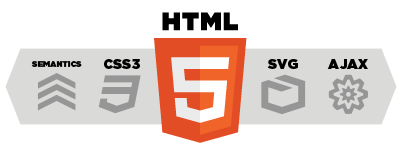To achieve drag and drop functionality with traditional HTML4, developers would either have to either have to use complex Javascript programming or other Javascript frameworks like jQuery etc.
Now HTML 5 came up with a Drag and Drop (DnD) API that brings native DnD support to the browser making it much easier to code up.
HTML 5 DnD is supported by all the major browsers like Chrome, Firefox 3.5 and Safari 4 etc.
Drag and Drop Events:
There are number of events which are fired during various stages of the drag and drop operation. These events are listed below:
| Events | Description |
|---|---|
| dragstart | Fires when the user starts dragging of the object. |
| dragenter | Fired when the mouse is first moved over the target element while a drag is occuring. A listener for this event should indicate whether a drop is allowed over this location. If there are no listeners, or the listeners perform no operations, then a drop is not allowed by default. |
| dragover | This event is fired as the mouse is moved over an element when a drag is occuring. Much of the time, the operation that occurs during a listener will be the same as the dragenter event. |
| dragleave | This event is fired when the mouse leaves an element while a drag is occuring. Listeners should remove any highlighting or insertion markers used for drop feedback. |
| drag | Fires every time the mouse is moved while the object is being dragged. |
| drop | The drop event is fired on the element where the drop was occured at the end of the drag operation. A listener would be responsible for retrieving the data being dragged and inserting it at the drop location. |
| dragend | Fires when the user releases the mouse button while dragging an object. |
Note: Note that only drag events are fired; mouse events such as mousemove are not fired during a drag operation.
The DataTransfer Object:
The event listener methods for all the drag and drop events accept Event object which has a readonly attribute called dataTransfer. The event.dataTransfer returns DataTransfer object associated with the event as follows:
function EnterHandler(event) {
DataTransfer dt = event.dataTransfer;
.............
}
The DataTransfer object holds data about the drag and drop operation. This data can be retrieved and set in terms of various attributes associated with DataTransfer object as explained below:
| S.N. | DataTransfer attrobutes and their description |
|---|---|
| 1 |
dataTransfer.dropEffect [ = value ]
|
| 2 |
dataTransfer.effectAllowed [ = value ]
|
| 3 |
dataTransfer.types Returns a DOMStringList listing the formats that were set in the dragstart event. In addition, if any files are being dragged, then one of the types will be the string "Files". |
| 4 |
dataTransfer.clearData( [ format ] ) Removes the data of the specified formats. Removes all data if the argument is omitted. |
| 5 |
dataTransfer.setData(format, data) Adds the specified data. |
| 6 |
data = dataTransfer.getData(format) Returns the specified data. If there is no such data, returns the empty string. |
| 7 |
dataTransfer.files Returns a FileList of the files being dragged, if any. |
| 8 |
dataTransfer.setDragImage(element, x, y) Uses the given element to update the drag feedback, replacing any previously specified feedback. |
| 9 |
dataTransfer.addElement(element) Adds the given element to the list of elements used to render the drag feedback. |
Drag and Drop Process:
Following are the steps to be carried out to implement Drag and Drop operation:
Step 1: Making an Object Draggable:
Here are steps to be taken:
- If you want to drag an element, you need to set the draggable attribute to true for that element.
- Set an event listener for dragstart that stores the data being dragged.
- The event listener dragstart will set the allowed effects (copy, move, link, or some combination).
Following is the example to make an object dragable:
<style type="text/css">
<ol><li>boxA, #boxB {li>ol> float:left;padding:10px;margin:10px; -moz-user-select:none;
}
<ol><li>boxA { background-color: #6633FF; width:75px; height:75px; }li><li>boxB { background-color: #FF6699; width:150px; height:150px; }li>ol>style>
<script type="text/javascript">
function dragStart(ev) {
ev.dataTransfer.effectAllowed='move';
ev.dataTransfer.setData("Text", ev.target.getAttribute('id'));
ev.dataTransfer.setDragImage(ev.target,0,0);
return true;
}
script>
<center>
<h2>Drag and drop HTML5 demoh2>
<div>Try to drag the purple box around.div>
<div id="boxA" draggable="true" ondragstart="return dragStart(event)">
<p>Drag Mep>
div>
<div id="boxB">Dustbindiv>
center>
Step 2: Dropping the Object:
To accept a drop, the drop target has to listen to at least three events.
The dragenter event, which is used to determine whether or not the drop target is to accept the drop. If the drop is to be accepted, then this event has to be canceled.
The dragover event, which is used to determine what feedback is to be shown to the user. If the event is canceled, then the feedback (typically the cursor) is updated based on the dropEffect attribute's value.
Finally, the drop event, which allows the actual drop to be performed.
Following is the example to drop an object into another object:
<style type="text/css">
<ol><li>boxA, #boxB {li>ol> float:left;padding:10px;margin:10px;-moz-user-select:none;
}
<ol><li>boxA { background-color: #6633FF; width:75px; height:75px; }li><li>boxB { background-color: #FF6699; width:150px; height:150px; }li>ol>style>
<script type="text/javascript">
function dragStart(ev) {
ev.dataTransfer.effectAllowed='move';
ev.dataTransfer.setData("Text", ev.target.getAttribute('id'));
ev.dataTransfer.setDragImage(ev.target,0,0);
return true;
}
function dragEnter(ev) {
event.preventDefault();
return true;
}
function dragOver(ev) {
return false;
}
function dragDrop(ev) {
var src = ev.dataTransfer.getData("Text");
ev.target.appendChild(document.getElementById(src));
ev.stopPropagation();
return false;
}
script>
<center>
<h2>Drag and drop HTML5 demoh2>
<div>Try to move the purple box into the pink box.div>
<div id="boxA" draggable="true" ondragstart="return dragStart(event)">
<p>Drag Mep>
div>
<div id="boxB" ondragenter="return dragEnter(event)" ondrop="return dragDrop(event)" ondragover="return dragOver(event)">Dustbindiv>
center>
-
Average:5
-
Letture(1069)
-
Trackback(0)
-
Permalink





















Commenti (0)